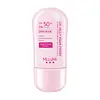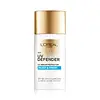What's inside
What's inside
 Key Ingredients
Key Ingredients

 Benefits
Benefits

 Concerns
Concerns

 Ingredients Side-by-side
Ingredients Side-by-side

Water
Skin ConditioningButylene Glycol
HumectantEthylhexyl Salicylate
UV AbsorberEthylhexyl Triazone
UV AbsorberDiethylamino Hydroxybenzoyl Hexyl Benzoate
UV FilterNeopentyl Glycol Diheptanoate
EmollientBis-Ethylhexyloxyphenol Methoxyphenyl Triazine
Skin ConditioningIsododecane
EmollientPEG-20 Glyceryl Triisostearate
EmollientDiisopropyl Adipate
EmollientPropylene Glycol Dicaprylate/Dicaprate
EmollientCaprylyl Methicone
Skin ConditioningSilica
AbrasivePropanediol
SolventC12-15 Alkyl Benzoate
AntimicrobialDiisopropyl Sebacate
EmollientCyclopentasiloxane
EmollientTitanium Dioxide
Cosmetic ColorantLauroyl Lysine
Skin ConditioningAluminum Starch Octenylsuccinate
AbsorbentSorbitan Sesquiisostearate
EmulsifyingAcrylates/Beheneth-25 Methacrylate Copolymer
Methylene Bis-Benzotriazolyl Tetramethylbutylphenol
UV FilterPPG-8-Ceteth-20
EmulsifyingMethylpropanediol
SolventSaccharomyces Ferment
Skin ConditioningCaprylic/Capric Triglyceride
MaskingCaprylyl Glycol
EmollientStearyl Glycyrrhetinate
Skin ConditioningMaltodextrin
AbsorbentTocopheryl Acetate
AntioxidantPolyquaternium-80
CleansingOctocrylene
UV AbsorberDecyl Glucoside
CleansingPistacia Lentiscus Gum
MaskingDisodium EDTA
Hydrogenated Lecithin
EmulsifyingDidecyldimonium Chloride
EmulsifyingButyl Methoxydibenzoylmethane
UV AbsorberAloe Barbadensis Leaf Water
MaskingPhenethyl Alcohol
MaskingPolysilicone-14
Tremella Fuciformis Polysaccharide
Emulsion StabilisingCaesalpinia Spinosa Fruit Extract
Skin ProtectingAlteromonas Ferment Extract
Skin ConditioningPropylene Glycol
Humectant3-Laurylglyceryl Ascorbate
AntioxidantEthylhexylglycerin
Skin ConditioningXanthan Gum
EmulsifyingHelianthus Annuus Sprout Extract
Skin ConditioningRosa Roxburghii Fruit Extract
TonicCamellia Sinensis Leaf Extract
AntimicrobialWater, Butylene Glycol, Ethylhexyl Salicylate, Ethylhexyl Triazone, Diethylamino Hydroxybenzoyl Hexyl Benzoate, Neopentyl Glycol Diheptanoate, Bis-Ethylhexyloxyphenol Methoxyphenyl Triazine, Isododecane, PEG-20 Glyceryl Triisostearate, Diisopropyl Adipate, Propylene Glycol Dicaprylate/Dicaprate, Caprylyl Methicone, Silica, Propanediol, C12-15 Alkyl Benzoate, Diisopropyl Sebacate, Cyclopentasiloxane, Titanium Dioxide, Lauroyl Lysine, Aluminum Starch Octenylsuccinate, Sorbitan Sesquiisostearate, Acrylates/Beheneth-25 Methacrylate Copolymer, Methylene Bis-Benzotriazolyl Tetramethylbutylphenol, PPG-8-Ceteth-20, Methylpropanediol, Saccharomyces Ferment, Caprylic/Capric Triglyceride, Caprylyl Glycol, Stearyl Glycyrrhetinate, Maltodextrin, Tocopheryl Acetate, Polyquaternium-80, Octocrylene, Decyl Glucoside, Pistacia Lentiscus Gum, Disodium EDTA, Hydrogenated Lecithin, Didecyldimonium Chloride, Butyl Methoxydibenzoylmethane, Aloe Barbadensis Leaf Water, Phenethyl Alcohol, Polysilicone-14, Tremella Fuciformis Polysaccharide, Caesalpinia Spinosa Fruit Extract, Alteromonas Ferment Extract, Propylene Glycol, 3-Laurylglyceryl Ascorbate, Ethylhexylglycerin, Xanthan Gum, Helianthus Annuus Sprout Extract, Rosa Roxburghii Fruit Extract, Camellia Sinensis Leaf Extract
Water
Skin ConditioningAlcohol Denat.
AntimicrobialEthylhexyl Triazone
UV AbsorberDrometrizole Trisiloxane
UV AbsorberIsononyl Isononanoate
EmollientIsopropyl Lauroyl Sarcosinate
Skin ConditioningButyl Methoxydibenzoylmethane
UV AbsorberDiisopropyl Sebacate
EmollientBis-Ethylhexyloxyphenol Methoxyphenyl Triazine
Skin ConditioningDimethicone
EmollientMethylene Bis-Benzotriazolyl Tetramethylbutylphenol
UV FilterPropanediol
SolventEthylhexyl Salicylate
UV AbsorberSilica
AbrasiveCetearyl Alcohol
EmollientT-Butyl Alcohol
PerfumingTocopherol
AntioxidantSodium Stearoyl Glutamate
CleansingHydrolyzed Hyaluronic Acid
HumectantPhenoxyethanol
PreservativePEG-10 Dimethicone
Skin ConditioningPEG-20
HumectantTrisodium Ethylenediamine Disuccinate
Polyglyceryl-10 Laurate
Skin ConditioningAmmonium Acryloyldimethyltaurate/Vp Copolymer
Limonene
PerfumingLinalool
PerfumingCaprylyl Glycol
EmollientAlpha-Isomethyl Ionone
PerfumingCarbomer
Emulsion StabilisingAcrylates/C10-30 Alkyl Acrylate Crosspolymer
Emulsion StabilisingButylene Glycol
HumectantCetearyl Glucoside
EmulsifyingPotassium Hydroxide
BufferingInulin Lauryl Carbamate
Emulsion StabilisingHexyl Cinnamal
PerfumingGlycerin
HumectantParfum
MaskingWater, Alcohol Denat., Ethylhexyl Triazone, Drometrizole Trisiloxane, Isononyl Isononanoate, Isopropyl Lauroyl Sarcosinate, Butyl Methoxydibenzoylmethane, Diisopropyl Sebacate, Bis-Ethylhexyloxyphenol Methoxyphenyl Triazine, Dimethicone, Methylene Bis-Benzotriazolyl Tetramethylbutylphenol, Propanediol, Ethylhexyl Salicylate, Silica, Cetearyl Alcohol, T-Butyl Alcohol, Tocopherol, Sodium Stearoyl Glutamate, Hydrolyzed Hyaluronic Acid, Phenoxyethanol, PEG-10 Dimethicone, PEG-20, Trisodium Ethylenediamine Disuccinate, Polyglyceryl-10 Laurate, Ammonium Acryloyldimethyltaurate/Vp Copolymer, Limonene, Linalool, Caprylyl Glycol, Alpha-Isomethyl Ionone, Carbomer, Acrylates/C10-30 Alkyl Acrylate Crosspolymer, Butylene Glycol, Cetearyl Glucoside, Potassium Hydroxide, Inulin Lauryl Carbamate, Hexyl Cinnamal, Glycerin, Parfum
Ingredients Explained
These ingredients are found in both products.
Ingredients higher up in an ingredient list are typically present in a larger amount.
You might know this ingredient as Tinosorb S or Bemotrizinol. It is a UV filter that covers both UVA and UVB rays.
This ingredient has two peak UV absorption peaks ( 310 and 340 nm) and is able to absorb both UV-A and UV-B rays. This ingredient works by preventing UV rays from reaching and damaging your skin.
On top of that - it is highly photostable and helps prevent the photodegration of other sunscreen ingredients such as avobenzone.
Tinosorb S is allowed in the EU, Australia, and Asia. It is close to being approved by the FDA and we'll hopefully get this ingredient in the U.S. by late 2025.
Fun fact: Tinosorb S is the most effective UV absorber at maximum concentration (measured by SPF) permitted in the EU.
This ingredient is oil-soluble, so your oil-cleansers will take this right off at night.
Learn more about Bis-Ethylhexyloxyphenol Methoxyphenyl TriazineAlso known as Avobenzone, this ingredient is a chemical sunscreen filter that provides protection in the UV-A range.
Avobenzone is globally approved and is the most commonly used UV-A filter in the world.
Studies have found that avobenzone becomes ineffective when exposed to UV light (it is not photostable; meaning that it breaks down in sunlight). Because of this, formulations that include avobenzone will usually contain stabilizers such as octocrylene.
However, some modern formulations (looking at you, EU!) are able to stabilize avobenzone by coating the molecules.
Avobenzone does not protect against the UV-B range, so it's important to check that the sunscreen you're using contains other UV filters that do!
The highest concentration of avobenzone permitted is 3% in the US, and 5% in the EU.
Learn more about Butyl MethoxydibenzoylmethaneButylene Glycol (or BG) is used within cosmetic products for a few different reasons:
Overall, Butylene Glycol is a safe and well-rounded ingredient that works well with other ingredients.
Though this ingredient works well with most skin types, some people with sensitive skin may experience a reaction such as allergic rashes, closed comedones, or itchiness.
Learn more about Butylene GlycolCaprylyl Glycol is a humectant and emollient, meaning it attracts and preserves moisture.
It is a common ingredient in many products, especially those designed to hydrate skin. The primary benefits are retaining moisture, skin softening, and promoting a healthy skin barrier.
Though Caprylyl Glycol is an alcohol derived from fatty acids, it is not the kind that can dry out skin.
This ingredient is also used as a preservative to extend the life of products. It has slight antimicrobial properties.
Learn more about Caprylyl GlycolWe don't have a description for Diisopropyl Sebacate yet.
Ethylhexyl Salicylate is an organic compound used to block UV rays. It primarily absorbs UVB rays but offers a small amount of UVA protection as well.
Commonly found in sunscreens, Ethylhexyl Salicylate is created from salicylic acid and 2-ethylhexanol. You might know salicylic acid as the effective acne fighter ingredient and BHA.
The ethylhexanol in this ingredient is a fatty alcohol and helps hydrate your skin, similar to oils. It is an emollient, which means it traps moisture into the skin.
According to manufacturers, Ethylhexyl Salicylate absorbs UV wavelength of 295-315 nm, with a peak absorption at 307-310 nm. UVA rays are linked to long term skin damage, such as hyperpigmentation. UVB rays emit more energy and are capable of damaging our DNA. UVB rays cause sunburn.
Learn more about Ethylhexyl SalicylateEthylhexyl Triazone is a modern chemical sunscreen that protects from UV-B radiation.
It is the most effective of existing UV-B filters, as it provides the highest level of photo-stable absorption. It protects from the entire UV-B range (280 to 320nm), with it's highest level of protection at 314nm.
Ethylhexyl Triazone is oil soluble, oderless and colorless, which mean it is able to be incorporated into a variety of different formulations.
It is not currently available within the United States due to slow changing FDA regulations. Outside of the US, it is used in formulations at concentrations up to 5%.
Learn more about Ethylhexyl TriazoneMethylene Bis-Benzotriazolyl Tetramethylbutylphenol (Tinosorb M) is a hybrid and broad-spectrum UV ingredient. It is both a UV absorber and filter.
UV absorbers are an agent that absorbs UV rays. They protect your skin by using chemical reactions to convert UV rays into heat and energy. UV filters physically reduce the amount of UV rays from reaching your skin.
Tinosorb M covers a range of 280-400 nm and is photostable. This ingredient is neither oil or water soluble.
Tinosorb M is not available in the US. However, it is available in the EU and Asia.
It's sister, Tinosorb S, is set to be approved in the US by late 2025 (fingers crossed!).
Learn more about Methylene Bis-Benzotriazolyl TetramethylbutylphenolPropanediol is an all-star ingredient. It softens, hydrates, and smooths the skin.
It’s often used to:
Propanediol is not likely to cause sensitivity and considered safe to use. It is derived from corn or petroleum with a clear color and no scent.
Learn more about PropanediolSilica, also known as silicon dioxide, is a naturally occurring mineral. It is used as a fine, spherical, and porous powder in cosmetics.
Though it has exfoliant properties, the function of silica varies depending on the product.
The unique structure of silica enhances the spreadability and adds smoothness, making it a great texture enhancer.
It is also used as an active carrier, emulsifier, and mattifier due to its ability to absorb excess oil.
In some products, tiny microneedles called spicules are made from silica or hydrolyzed sponge. When you rub them in, they lightly polish away dead skin layers and enhance the penetration of active ingredients.
Learn more about SilicaWater. It's the most common cosmetic ingredient of all. You'll usually see it at the top of ingredient lists, meaning that it makes up the largest part of the product.
So why is it so popular? Water most often acts as a solvent - this means that it helps dissolve other ingredients into the formulation.
You'll also recognize water as that liquid we all need to stay alive. If you see this, drink a glass of water. Stay hydrated!
Learn more about Water